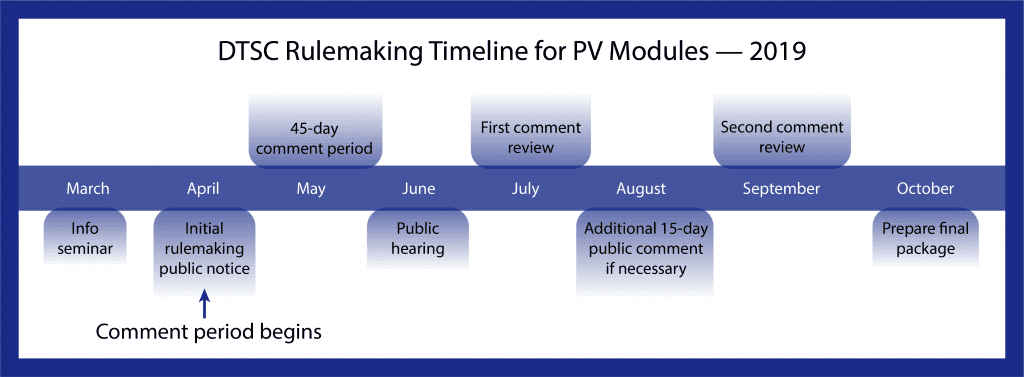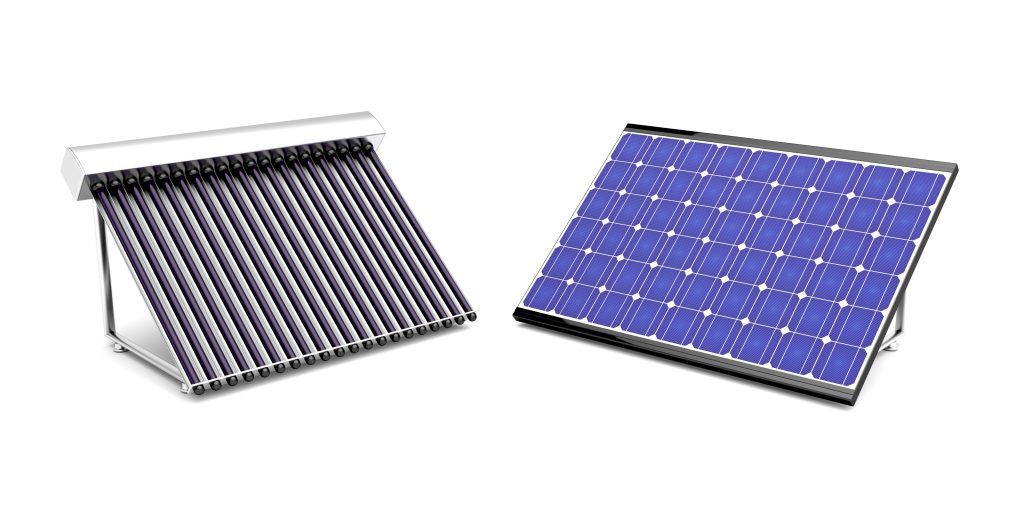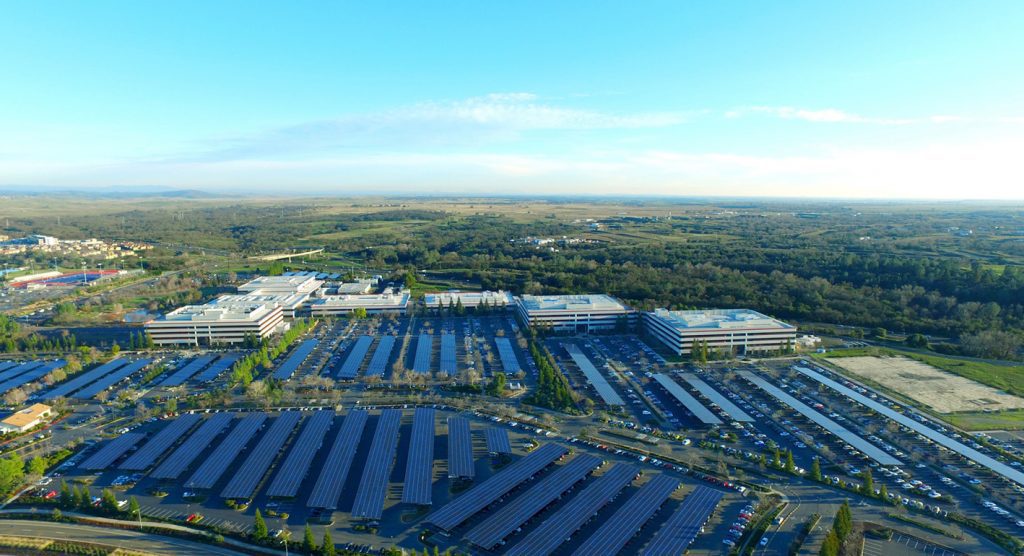
Photovoltaic Solar Panel Disposal in California

Written by: Virginia McCormick, NES, Inc.

As photovoltaic solar panels become more prevalent, disposal may pose a unique challenge.
DTSC Considers Universal Waste Management for Photovoltaic Solar Panels
On March 25, 2019, the California Department of Toxic Substances Control (DTSC) held a public seminar on proposed regulations regarding the disposal of photovoltaic modules – more commonly known as solar panels. The DTSC seminar was held to consider the inclusion of photovoltaic solar panels as universal waste under California’s Universal Waste Program.
According to current California regulations, discarded photovoltaic solar panels are classified as hazardous waste due to the potential levels of heavy metals included in certain electrical components. Hazardous waste is defined as any waste that has the potential to threaten public health or the environment, and it typically exhibits one or more of the following traits: ignitability, reactivity, corrosivity, or toxicity. The intention is that managing photovoltaic solar panels as universal waste may open an avenue up to safer, easier, and more cost-effective disposal.
California’s Universal Waste Program
If the proposed regulations pass, photovoltaic solar panels would be included on the list of hazardous wastes eligible to be managed under California’s Universal Waste Program. Universal waste is defined as a category of hazardous waste that is typically produced by households and businesses and generally poses a lower threat to human and environmental health. Common universal wastes include televisions, fluorescent lamps, and batteries.
In California, universal wastes are known as being easier to dispose of safely compared to typical hazardous wastes, which have special requirements and permits that need to be adhered to. According to the DTSC universal waste fact sheet, “the more relaxed requirements for managing universal wastes were adopted to ensure that they are managed safely and are not disposed of in the trash.”

The DTSC has proposed the above timeline for rulemaking regarding solar panel disposal.
However, universal waste cannot simply be thrown in the trash. Under California’s Universal Waste Program, universal waste must be sent to a facility authorized to collect, recycle, or dispose of it. If photovoltaic solar panels are reclassified as universal wastes, this will become the standard for disposal of modules that meet universal waste definitions.
Thermal vs. Photovoltaic Solar Panels
There are several different kinds of solar cell technologies currently being using in solar panel manufacturing. However, the two most established forms of solar power technologies are photovoltaic and solar thermal.
Solar thermal technology uses mirrors to concentrate sunlight. That sunlight is then used either directly as a source of heat or to drive a heat cycle within an engine.

A solar thermal panel is shown on the left in the graphic above; a photovoltaic solar panel is shown on the right.
Solar photovoltaic panels are more widely used today than solar thermal, despite being the newer of the two technologies. Photovoltaic solar panels, which use semi-conductor technology to convert sunlight directly into electricity, are those currently being considered in California for reclassification as universal waste.
It is important to note that not all solar panels are considered as hazardous; this designation depends on how the panels are manufactured. Generators are responsible for hazardous waste determination, and categorizing photovoltaic solar panels as universal waste would allow generators to manage the waste without testing. The proposed regulation change is being promoted as a simplified and environmentally conscious method of disposal for solar panels, which in turn renders implementation of solar panels a more appealing option.
Photovoltaic Solar Panels Popular in California
In 2016, Intel Corporation unveiled a solar carport installation at its Folsom, CA campus. The installation increased Intel’s solar power generation to more than 50% of the campus energy use. At the time of completion, the tech company reported the solar array as the largest corporate solar carport in the country.

Intel’s Folsom campus hosts one of many examples of California’s massive solar panel arrays. Source: Intel Newsroom
Solar power is becoming increasingly prevalent in California, and Intel’s Folsom array is just one of thousands of solar panel constructions in the state. According to the California Energy Commission, California is the highest solar power-generating state in the nation with an estimated 946,740 solar projects and 704 operating solar power plants. Data from Solar Energy Industries Association show just under three thousand solar companies operating in California and an installation price decline of nearly 50% over the last five years.
Solar panel use in California is not expected to drop any time soon. In fact, in May of 2018, California became the first in the nation to approve a statewide solar panel mandate, which would require photovoltaic solar panel installation in virtually all new home construction.
Most photovoltaic solar panels are warrantied to maintain peak energy production for approximately 25 years, and installation only started to pick up in 2010. Because of this, current photovoltaic solar panel recycling primarily consists of replacing small amounts of panels that get damaged by weather or accidents.
The impetus behind the DTSC seminar and proposed regulations is that California will soon be dealing with a large influx of old photovoltaic solar panels that are considered hazardous waste. This will have a drastic impact on California landfills as the current wave of panels become obsolete. For many, the idea of tons of solar panel hazardous waste crowding landfills in coming decades runs counter to the eco-conscious ideal that solar panels are intended to live up to.
Later this year, DTSC plans to move forward with the proposed photovoltaic solar panel regulations. Given the inevitable future influx of this waste, properly managing end-of-life solar panels in the present is anticipated to lessen the degree of damage to human and environmental health.
NES & Environmental Health
NES has been providing EH&S training and consulting services on behalf of a wide array of public and private businesses and government agencies for the past 30 years. We provide hazardous waste management training in open enrollment format and on-site at clients’ facilities throughout California and beyond. We also provide hazardous waste management and universal waste management training on behalf of select California CUPAs. To learn more about NES’ EH&S training and consulting services, please contact NES at 916-353-2360 / 1-800-NES-ADVISE (1-800-637-2384) or office@nesglobal.net.
References:
California Department of Toxic Substances Control: Photovoltaic Modules (PV modules) – Universal Waste Management Regulations
California Department of Toxic Substances Control: Solar Panel FAQs
CalRecycle: Universal Waste
California Department of Toxic Substances Control: Universal Waste Fact Sheet
Managing Universal Waste in California
Stanford University, Materials Science and Engineering: An Overview of Solar Cell Technology
Intel Newsroom: Chip Shot: Intel unveils largest corporate solar carport in the U.S. at Folsom, Calif. campus
The Sacramento Bee: Intel campus in Folsom unveils sprawling solar power carport
California Distributed Generation Statistics: California Leads the Nation in Distributed Generation
Solar Energy Industries Association: Solar Spotlight – California
KCRA: Regulator OKs solar panel mandate for new California homes
